There They Are 2a4 s Left 10 O clock Level Continuous Left Turn Topgun
Top Gun: Maverick revolutionized aerial cinematography by placing actors and camera systems directly in the cockpit of real fighter jets. The result was authentic performances that could never be replicated with CGI. While audiences today are all too familiar with CGI in their action flicks, the over-polished feel of green screen technology is still very much perceptible to the average viewer. After experiencing a film that opts for practical solutions like Top Gun: Maverick, it recalibrates your cinematic barometer.
As Jerry Bruckheimer says, "We're going to really show you what it takes to be a TOP GUN pilot." Bruckheimer goes on to remark that the chances of another aviation film of this caliber are unlikely to happen again anytime soon.
The filmmakers combined the latest in camera technology with elite pilot advisors and a little movie magic to capture the visceral impact of Mach-speed aviation. We will take a closer look below at how exactly they achieved such amazing aerial cinematography from highlighting camera rigs that fit in the limited space of cockpits, training the cast to help manage cinematography duties, and collaborating with experts from the U.S. Navy and Lockheed Martin.
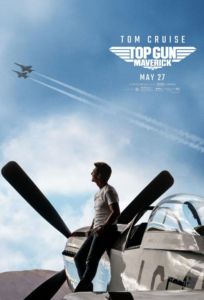
The film's star Tom Cruise describes Maverick best – it's a "true love letter to aviation."
- Tech Specs
- The Sequel
- Production Design
- Cinematography
- Aerial Stunts
- Limited Computer-generated Imagery (CGI)
✈ Top Gun Maverick Tech Specs ✈

- Runtime: 2 hr 10 min (130 min)
- Color: Color
- Aspect Ratio: 2.39:1, 1.90:1 (for IMAX presentation)
- Cameras: Sony Venice
- Lenses: Main Unit | Sigma Prime; Arri/Zeiss Master Prime; Zeiss Compact Zoom; Fujifilm/Fujinon Premier Zoom, Premista Zoom; Cinemagic Revolution snorkel-lens system || Jet Interior and Exterior | Voigtländer Heliar Hyper Wide, Ultra Wide, Super Wide; Zeiss Loxia || Air-to-Air | Fujifilm/Fujinon Cabrio zoom || Ground-to-Air | Fujifilm/Fujinon Premier Zoom; Canon zoom, prime
- Laboratory: Company 3, Los Angeles (CA), USA (digital intermediate) (dailies)
- EC3 (dailies)
- Negative Format: AXS-R7
- Cinematographic Process: Digital Intermediate (4K) (master format)
- X-OOCN ST (6K) (source format)
- Printed Film Format: D-Cinema (also 3-D version)
- DCP Digital Cinema Package 4K
✈ Top Gun Sequel ✈

Top Gun (1986) is known for cocky fighter pilots, daring aerial feats, and most of all, camaraderie. The original film was directed by the late Tony Scott , lensed by cinematographer Jeffrey L. Kimball, ASC , and produced by the conjoined forces of Don Simpson and Jerry Bruckheimer.
For Top Gun: Maverick , on the other hand, Bruckheimer would remain as one of the few key players from the original film. Joseph Kosinski filled the large shoes of Tony Scott and Claudio Miranda bridged the visual language between the 1986 and Maverick . Miranda and Kosinski first collaborated together on another sequel – Tron: Legacy – and worked with Cruise on the sci-fi epic Oblivion . While on Tron: Legacy they didn't follow the visual language as closely as the original. That wasn't necessarily the case for Top Gun: Maverick which built upon the original's visual themes.
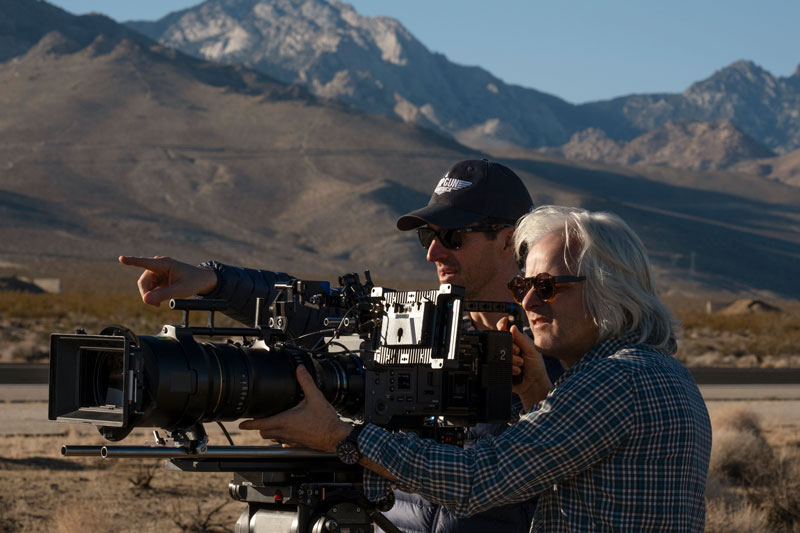
DP Claudio Miranda and director Joseph Kosinski on Top Gun: Maverick, CBS Corporation
How does the sequel compare to the much-beloved original?
Like the first film, Top Gun Maverick follows a new generation of an elite squadron of ace pilots. While the filmmakers wanted to retain what audiences loved about the original, they also wanted to push the boundaries of what was possible.

Top Gun (1986)
"Every time we approach a new project, we go into it with the intent of trying something new and shaking things up for us in terms of its technical aspects and visual style. For Maverick, it was about capturing the experience of actually being in one of these fighter jets while it's in the air. That's how we were able to go beyond the first film." –Joseph Kosinski, ASC Mag
The original 1986 Paramount Pictures film parallels a sports movie a la locker room scenes, competitive sequences, and winning a trophy. However, as naval advisor Capt. J.J. Cummings puts it , "If you try to make a sports movie after we've been at war since 2001 […] – you're going to lose the military audience."
A New Approach…
Thus, Top Gun: Maverick takes a more sobering, yet technical direction. Capt. Pete "Maverick" Mitchell (Cruise) is now a weathered test pilot. Unlike his contemporaries who have long been promoted out of the cockpit into administrative roles, Maverick flies the most cutting-edge aviation technology produced by Skunk Works. And with a new generation of naval graduates, Maverick is called back to the San Diego air base from the first film to train them for a dangerous mission.

Tom Cruise on the set of Top Gun: Maverick from Paramount Pictures, Skydance and Jerry Bruckheimer Films.
Screenwriters Christopher McQuarrie was afraid that if he thought about the original too much that he would overthink their story and over-correct it. Rather than try to top the original, they just tried to make a worthy movie that could fly with its own two wings.
Not Just "Top Gun 2"
Taking off 36 years later, Top Gun: Maverick is now a box office smash hit like its predecessor and serves as Tom Cruise's highest-grossing movie at the domestic box office. But, in the beginning, Cruise wasn't entirely on board to reprise the role of Maverick. In fact, the film's director, Joseph Kosinski, was asked by Bruckheimer to pitch the film to Cruise. Kosinski flew to Paris and had 30 minutes to convince Cruise in between setups of the latest Mission: Impossible production .
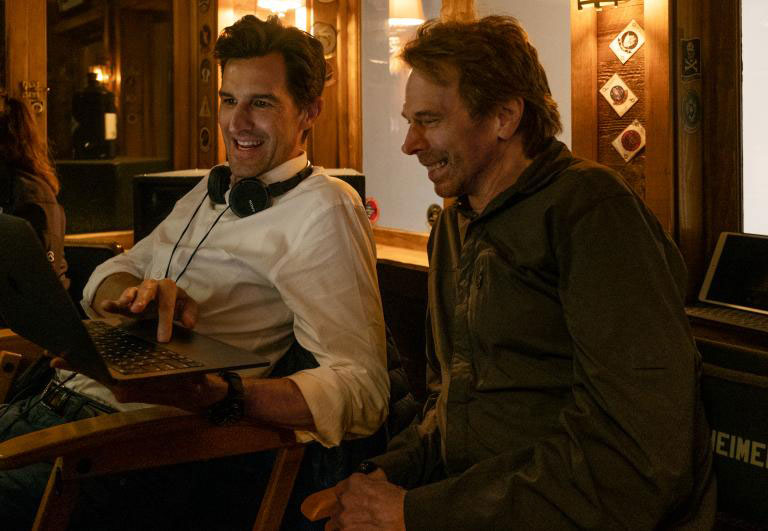
Joseph Kosinski and Jerry Bruckheimer on the set of Top Gun: Maverick from Paramount Pictures, Skydance and Jerry Bruckheimer Films.
It was when he landed in Paris before the pitch when Kosinski received a call from Cruise telling him no matter what happened, it would be good to see him. Kosinski didn't know until then that Cruise wasn't feeling the Top Gun sequel.
The Pitch
Regarding his pitch, Kosinski tells Cinema Blend:
"But because I had made a film with him before, I knew I had to grab him emotionally. So I opened with the idea that this is a rite-of-passage story like the first film. The first film is a drama, even though it's wrapped in this glossy action film. This would be the same thing, but it would be Maverick reconciling with Goose's son set against this mission that would take them both deep into enemy territory. And as soon as I said that, I could see the wheels in his head start to turn.
"Then I pitched the idea of Darkstar, the opening sequence, what Maverick's doing when we find him. Which I think was also important because Maverick is still Maverick, but he's not buzzing the tower at the local air base. He's on the cutting edge of aviation, pushing the envelope as always. But he's alone. He's alone at the beginning of this film. Then I talked about shooting practically, and obviously Tom's 100% in for all that. And then the title. I said we can't call it Top Gun 2. We've got to call it Top Gun: Maverick — a character story. So he pulled out his phone, called the head of Paramount, and said, 'We're making a sequel to Top Gun.' And it was boom, green light."
During the pitch, Kosinski showed Cruise videos of Navy pilots who rigged GoPros inside their cockpits. He told him that if they can't beat this, there's no point in shooting the film. The way Kosinski described the film was as a drama with an action film around it.
✈ Production Design ✈

The production design for the film was largely facilitated by the U.S. Navy and a list of advisors. Due to this support, the filmmakers didn't need to recreate naval bases or aircraft because they had access across the board. This meant that they had real locker rooms, bars, and hangars in San Diego and Nevada.
Top Gun: Maverick Locations:
- W 40th Street in San Pedro, California
- Inyokern Airport – "Kodiak" Hangar in California
- Breakers Beach, San Diego, California
- Rimrock Lake in Yakima, Washington
- Naval Air Station Fallon – Bravo-20 in Nevada
- Naval Air Weapons Station China Lake, California
- Fort Rosecrans National Cemetery, San Diego, California
- North Island Naval Air Station – Entrance in San Diego, California
- The Hard Deck (fictional) in San Diego, California
- Naval Air Station North Island, San Diego, California
- Washoe Meadows State Park in South Lake Tahoe, California
Production designer Jeremy Hindle describes Top Gun: Maverick as a romance, "not sexually but how it's lit and the way it feels warm and emotional." Hindle recounts how Cruise told him at the beginning of production that the film is about family, and "it's what people need."
Top Gun Aircraft
It was no easy feat for Hindle to find the iconic jet from the original film – a Grumman F-14 Tomcat – since they were decommissioned by the U.S. Navy. In fact, there are only six F-14s and they're available only in Iran. Fortunately, they found a model at the San Diego Air and Space Museum thanks to their Navy advisors. However, it didn't have an engine and had to be dismantled and shipped to them. The challenge was to make the F-14 model operational enough to open the cockpit. When you see the jet in the climactic dogfight sequence, it's actually a F/A-18 digitally re-skinned to look like the Tomcat.
Hindle landed 20 other aircraft for characters such as Lt. Bradley "Rooster" Bradshaw ( Miles Teller ) and Jake "Hangman" Seresin ( Glen Powell ). In an interview with Variety , Hindle says, "We collected those from all over the country because these were planes that are working, flying, and still doing their jobs." The only plane that Hindle didn't need to procure was the P-51 World War II fighter that Maverick works on at the beginning of the film. It's not only owned by Cruise, but he took the liberty of personally flying it from Florida to California.

Tom Cruise flying his personal P-51 Mustang. Image credit: Sony
The Darkstar
Perhaps the most notable aircraft in Top Gun: Maverick is the first jet that appeared in the film. From the opening sequence, Maverick pilots the Darkstar, an experimental, top-secret aeronautic project that's supposedly the fastest jet ever constructed. In the engineering of the Darkstar project, the filmmakers had the help of Skunk Works , Lockheed Martin's infamous division.
While the Darkstar is fictional, it's modeled after the SR-71 Blackbird. The SR-71 was developed by Skunk Works in the 1960s and is the fastest aircraft ever made. At its top speed of 2,100 MPH, it could outrun most missiles. The futuristic Darkstar, on the other hand, is developed with hypersonic technology and capable of speeds upward of 60 miles per minute .
Behind the Scenes with Skunk Works
Along with Skunk Work designers, the filmmaker designers developed a full-scale prototype of the Darkstar. They lowered the Darkstar closer to the ground than the SR-71 and made it even more sleek and angular. Of working with Skunk Works, Hindle says, "The cockpit was mindblowing. The intel of where everything would be for a pilot – you really wanted to believe that it was real. Through their design team, we learned how to make the plane look angry, mean, insanely fast…"
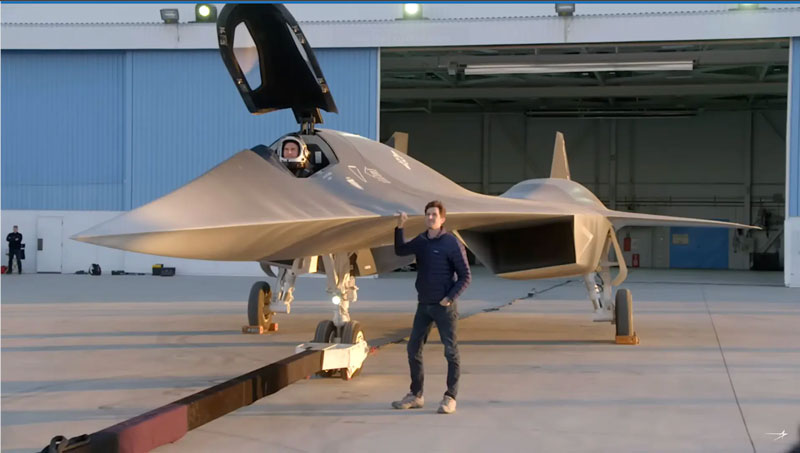
Filming of the Darkstar took place at a hangar located in China Lake, California. "'You can film anything you want, except for this building over there,'" the film's director recounts from a conversation he had with Navy personnel, "Of course, I just instantly became focused on this hangar in this corner surrounded by barbed wire. You know, I said, 'That looks like the perfect location for what we're trying to do.' They said, 'Don't even think about it.' I go, 'Can we drive over there? Take a picture?' They let me do that. Then, I said, 'God, it'd really be great to shoot here if I could.' Cut to two weeks later, they call us back and they say, 'Alright. You can shoot this hangar. Just tell us when and we'll take whatever's inside that out.' So, yeah, we got to shoot that sequence in that very special place."
Character Graphics
The character designs for the pilots were articulated through their call signs. The imagery on their helmets was motivated by the original film. In fact, the graphics were so popular among pilots after the original 1986 Top Gun , that it inspired the next generation to adopt the design. "It was Tony's [Scott] idea on the first movie," says Hindle, "and now everyone does it." Before Top Gun , Navy pilots didn't adorn the graphics of their call signs on their helmets.
The filmmakers recognized that the graphics on the helmets provide a window into each character for the audience, from Hangman to Rooster. Hindle worked alongside Kosinkski, a graphic artist, and an illustrator to design the character helmets.
The I-Bar
Anyone familiar with the culture surrounding Naval aviators is also probably aware of their notorious haunts where officers hang out. That's why the I-Bar in the film had to be true to life. The design had to include all the details like the personal mugs that every stationed officer brings with them and are subsequently kept on hooks.

Monica Barbaro plays Phoenix, Lewis Pullman plays Bob, Jay Ellis plays Payback and Miles Teller plays Rooster in Top Gun: Maverick from Paramount Pictures, Skydance and Jerry Bruckheimer Films.
"It's this old bar," says Hindle. "Everything in the Navy has this old feel to it, you feel their history because they pass everything on. They don't tear it down and build on it, and that's how we wanted this bar to look." All of the set dressing was authentic including the tail wings and plaques that decorated the walls.
In Top Gun: Maverick , the I-Bar belongs to Penny ( Jennifer Connelly ) who inherited it. They constructed the bar on the beach after Hindle searched for the perfect location in vain. "I scoured bars all along the beach in San Diego, but nothing worked," says Hindle. "We actually built it in L.A., completely made of steel and dressed it so I could see it, but then we dismantled it and rebuilt it on the beach."

Christopher Mcquarrie, Tommy Harper, Jerry Bruckheimer and Joseph Kosinski on the set of Top Gun: Maverick from Paramount Pictures, Skydance and Jerry Bruckheimer Films.
✈ Cinematography ✈

Top Gun: Maverick really stands out beyond its predecessor with its in-flight cinematography. It feels much more intimate and real since the actors feel the real effects of flying in a jet capable of heavy G-force. In order to thrill audiences, Tom Cruise understood that "you just can't create this kind of experience unless you shoot it live."
Making it a reality, the filmmakers teamed up with the U.S. Navy and the TOP GUN school to shoot the film practically. Workdays typically consisted of 14 hours and resulted in roughly 30 seconds of good footage. It took months of aerial shooting which amounted to an estimated 800 hours of footage. At times, even 27 cameras rolled simultaneously. Miranda shot in 6K full-frame and framed for 2.39:1 and IMAX 1.9:1 – with the exception of when they shot on lenses that didn't cover the Sony Venice's full sensor.
The director of photography Claudio Miranda previously won an Oscar for his work on Life of Pi . So, obviously, he's no stranger to green screen and seamless VFX put to fantastical effect. Speaking of his collaboration with Kosinski to the LA Times , Miranda says, "Joe and I always try to figure out how to be as real as possible by filming in-camera and using natural lighting."

Director Joseph Kosinski on the set of Top Gun: Maverick from Paramount Pictures, Skydance and Jerry Bruckheimer Films.
Inspiration, Not Imitation from the Past
To overcome the challenges of practical effects, Miranda consulted with the original Top Gun DP, Jeffrey L. Kimball, ASC. In order to get the deep shadows and a dusty look that's reminiscent of the 1984 imagery, they employed graduated filtration along with adding digital film grain during the final grade with Company 3 for "a little bit of antiquing." While they achieved a warmer look, they also were in tune with embedding their own visual flavor.
Learning the Mechanics of Flight Cinematography
The cast were not the only ones to launch into hyperdrive. In order to construct his camera rigs, Miranda climbed into the cockpit and hit speeds of around 4 Gs. During his experience in production, the cinematographer also acquired a pilot's license. Miranda and his team ran months of camera tests, experimenting with in-cabin rigs. They found their sweet spot with a six-camera setup in two Boeing F/A-18 Super Hornet fighter jets.
By reviewing the test footage, Claudio learned from how his own body reacted in flight.
"Because we were doing experiments with cameras I was reading menus and I realized that's a terrible idea — as you're spinning, I'm in the plane trying to reset the camera," he said. "Anyway, I didn't feel very good after that." – Claudio Miranda, LA Times
The film's aerial coordinator, Kevin LaRosa, Jr. , tells GQ, "Our cast had to be in the aircraft for every shot. So when they're delivering those epic performances, they are really in there pulling those Gs. Production went to great lengths to design that in-cockpit IMAX camera set up so those actors could be in there, doing that."

Motion Picture Aerial Coordinator and Stunt Pilot Kevin LaRosa II takes a moment between aerial sequences on-set of the next Hollywood blockbuster with the CineJet.
Lenses
To keep in stride with the original, Miranda decided to shoot Top Gun: Maverick with spherical lenses. When choosing lenses, especially for aerial photography, he knew that size mattered. "In jet cockpits, when you're pulling five to seven Gs, 10 pounds becomes 50 to 70 pounds, so we needed small and lightweight lenses with close focus."
Main-unit prime lens package
- Sigma High-Speed Cine primes (14mm-40mm range)
- Arri/Zeiss Master Primes (50mm upwards)
- A set of three Fujifilm/Fujinon Premier Zooms (18mm-400mm)
- And Premista 28-100mm T2.9 zoom
- 3 Zeiss Compact Zooms (15mm-200mm)
Ground-to-Air unit package
- 2 Premier zooms (24mm-400mm)
- 2 rehoused Canon lenses (a 150-600mm still zoom and a 1,000mm telephoto lens; both capable of covering 6K full-frame)
Operators deployed IBE Optics PLx2 extenders at extended focal lengths to track aircraft far off in the distance. At some points, the operators even mounted modified rifle scopes on their camera packages to keep the aircraft in their sites.
Aerial Photography
As previously mentioned, one of the primary goals of Top Gun: Maverick was to exceed all other films centered on aeronautics. In order to achieve such a feat, they had to push beyond green screens and push the limits of what was possible. Placing the actors in aircraft at top speeds allowed them to capture authentic expressions.
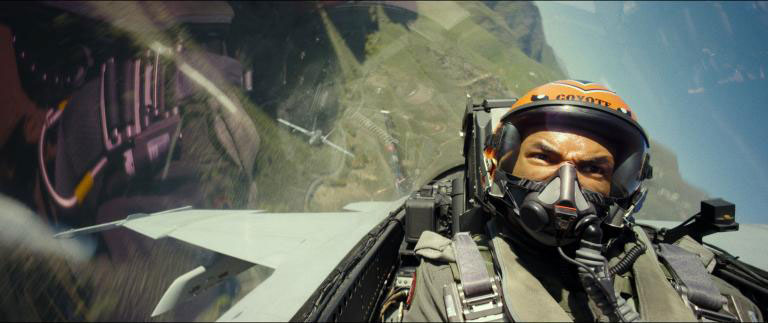
Greg Tarzan Davis plays "Coyote" in Top Gun: Maverick from Paramount Pictures, Skydance and Jerry Bruckheimer Films.
The aerial sequences were shot across California, Nevada, and the state of Washington. They are comprised of three primary elements:
- Ground-to-Air
- Onboard
- Air-to-Air
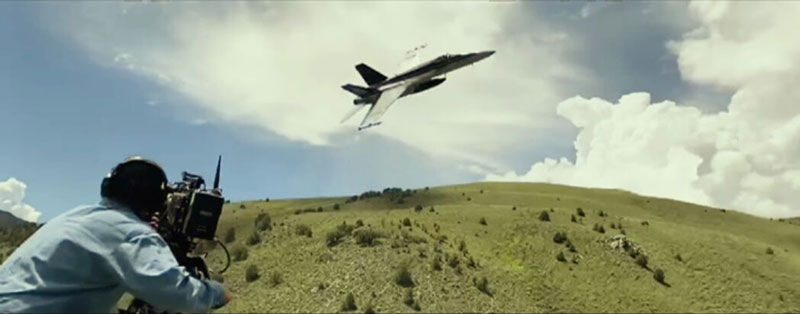
Ground-to-Air, Top Gun: Maverick
Two additional cinematographers were hired to assist with the aerial cinematography – David B. Nowell, ASC and Michael FitzMaurice . Together, using their iPhones, they developed makeshift animatics with stick-model airplanes.
"We built an aerial menu book of the most exciting and exhilarating camera angles and maneuvers that we could think of," LaRosa recollects to ASC Magazine . "Then, we'd go and test them with real aircraft. We'd learn what worked and what didn't."
Onboard Photography
With the tremendous expense of getting the jets off the ground, the camera systems had to provide as many camera angles as possible to get the coverage they needed. However, it wasn't as simple as cramming in the best cameras in the cockpit. The camera systems not only had to withstand the force of 7+ Gs without rattling but they also had to pass an approval process with the Navy to maintain safety standards.
Since the actors (obviously) didn't fly themselves, the filmmakers opted for F/A-18 models because they look similar to F-18s but include two seats – one for the pilot and the other for the weapons system operator in the back. It was all courtesy of the Department of Defense at $11,000 an hour. The actors sat in the back seat but filmed as if they were in the pilot's seat. Four rear-facing cameras captured the actors while two forward-facing cameras captured the controls in the front with the pilot.
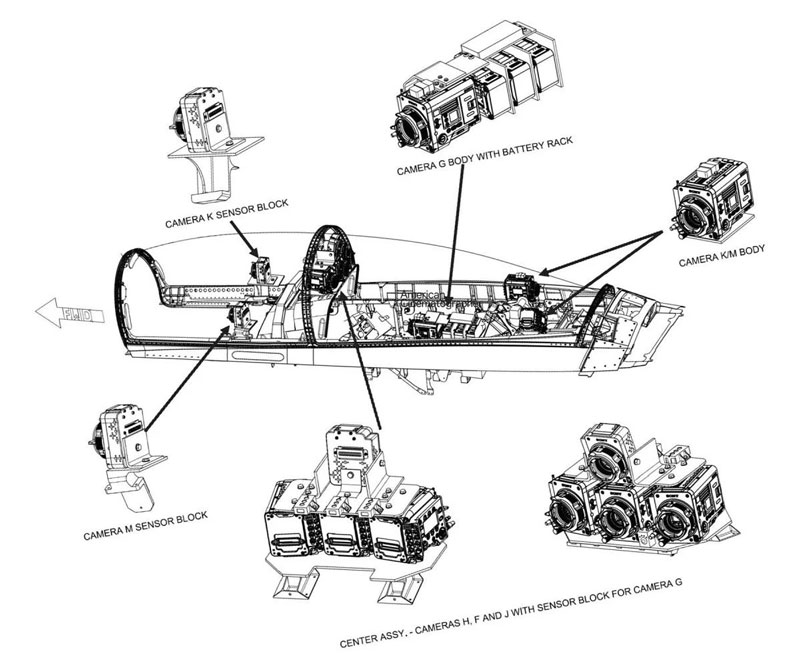
Cameras in the cockpit

Above: Center Assy. – Cameras H, F, and J with Sensor Block for Camera G
Onboard Camera Rigs
Miranda told ASC Magazine that "to ensure the rigs' viability, NAVAIR subjected them to shock, vibration and wind-tunnel testing at Naval Air Station Patuxent River in Maryland." At first, NAVAIR engineers told Miranda that a six-camera setup wasn't feasible. The filmmakers were challenged to think outside the box.
In order to turn their camera system into reality, they located two F/A-18 jets without the modern heads-up displays. This freed them up to replace the cockpit's video-recorder systems and other hardware with their battery-powered camera systems. Miranda was assisted by both his 1st AC Dan Ming and key grip Trevor Fulks in conceptualizing the six-camera setup for each F/A-18F. Fulks designed plates to mount to the cockpit's existing threaded holes in order to rig their equipment.

1st AC Dan Ming prepares the cockpit with cameras mounted to the jet.
The Rialto System
Pointing back at the weapons-systems officer's seat where the actors sat was three standard Venice units. Each setup included the Rialto system to extend the 6K Sony Venice Digital Cinema cameras' sensor blocks and separate them from the body with an extension cable. The cameras were rigged to capture over-the-shoulders (OTS) and inward-facing shots.
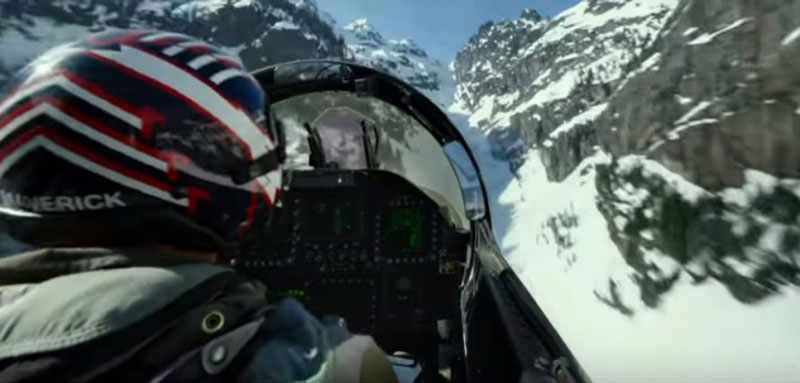
A Rialto system was arranged forward over the non-actor pilot's left and right shoulder for the OTS shots. The camera bodies were mounted behind the rear seat and the sensor blocks were mounted to the inside canopy. Since production Rialtos are too sturdy for the safety of their aerial circumstances, the filmmakers used prototypes of the Rialto with cables that could easily rip out of the sensor blocks. That way, the seats could eject in case of an emergency.
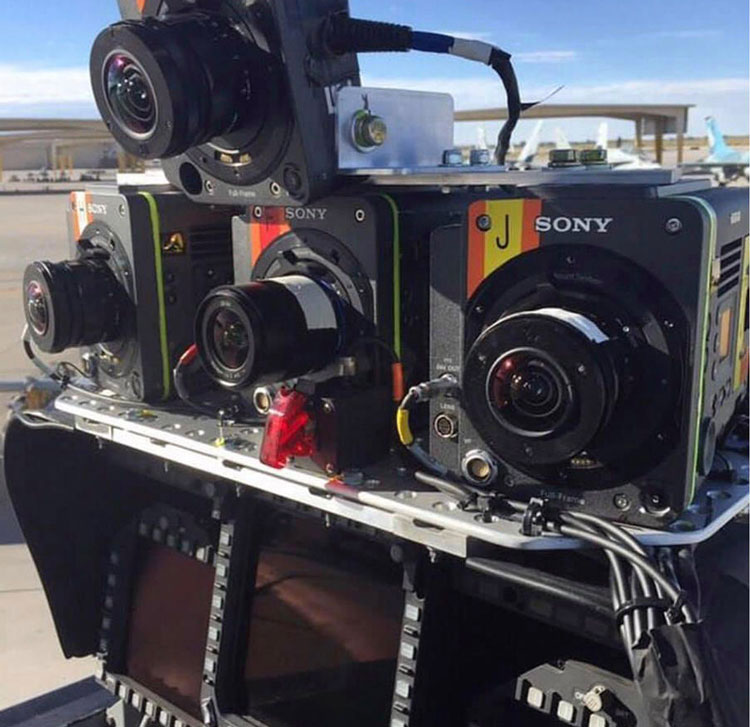
Image credit: Sony
On the other hand, the rear-facing cameras capturing the actors were each mounted over the glare shield which is located above the console. The body, however, was mounted in the rear atop the jet's light-control box.
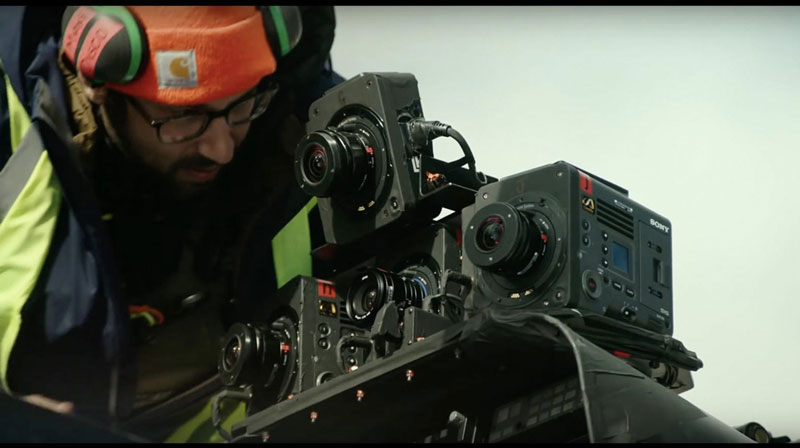
Image credit: Sony
Onboard Lenses
Weight was also a considerable factor. They utilized light, compact lenses with close focus. Not only did they keep the camera's profile slim, but they couldn't extend past the glare shield or obstruct the ejection seat. Fortunately, they didn't need to worry about the extra girth of matte boxes since the Venice also has internal NDs.
Lightweight Lenses
- Voigtländer Heliar wide-angle 10mm, 12mm, and 15mm E-mount primes
- Zeiss Loxia 21mm, 25mm, 35mm, 50mm E-mount primes
Onboard Lighting
The sun was the primary source of light. However, without personally traveling on the aircraft to determine the best position of the aircraft, Miranda had to communicate his needs to the pilots and actors before each run. His goal was for the pilots to backlight the F/A-18s so the sun was ¾ from the rear on both sides.
Under such conditions, they had to guesstimate their exposure – and once they set the stop there was no turning back. Miranda studied the flight paths and weather conditions during his prep before each day. This process helped inform how he set the camera exposures.
"It got really nerve-racking because it's really hard to predict," Miranda tells the LA Times . "I had to set one exposure basically because we're not auto exposing the cameras and they're really specific. So I'd have to look 50 miles [ahead] where they're going and know the terrain, how deep they're going to go, and then set the exposure and hope on the way over there the weather doesn't change."
Exterior Mounts
The next meteoric challenge was securing the cameras to the aircraft's exterior in a way that would produce usable footage. They also had to consider the limitations. For instance, the way the cameras were mounted to the exterior would affect the maneuver they could execute. The jets harbor inborne safety settings that won't allow them to pull upward of 7 Gs or roll if they sense any extra weight on a wing. But Miranda notes that they would get full performance as long as the cameras were secured instead to the body or inside the cockpit of the aircraft.
1st AC Dan Ming explains to ASC Magazine that certain maneuvers triggered extreme vibration; something that was realized when a camera came back damaged during testing. In addition, they experienced movement with the internal NDs from the vibrations. So, Ming suggested to Sony that they test the cameras with a paint mixer to replicate what they were experiencing with the jets.
Altogether, the production amassed one exterior-rigged aircraft and two interior-rigged aircraft. Ming specifies that since the exterior rigs resulted in limited performance, they kept them separate from the interior rigs.
The Solution
With the help of NAVAIR, they secured the cameras to the aircraft by building custom housing. They mounted the Sony Venice bodies to face the front and rear from the underside of the centerline, and then another one at the bottom of the wing facing the fuselage. The lenses used were Heliar wide-angle primes.
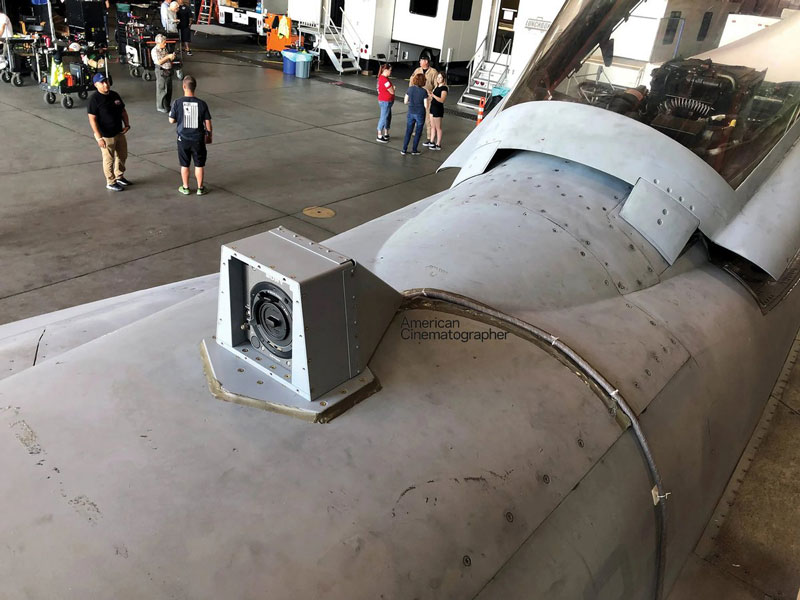
Camera mounted to exterior of jet with custom housing
To capture Tom Cruise, Miranda mounted a wide-angle lens and turned it inward.
"Normally it's not a flattering lens because if people get off to the side, they get stretched in a funny way," says Miranda. "But since Tom stays mainly in the middle of it, it doesn't hurt and looks kind of bad ass to see all this ground around him."
Amidst test flights, Miranda noticed how he could increase the cinematic experience with low-altitude flights through speeding vistas. Normally, the jets fly above the clouds but while low, the speed of the aircraft appears heightened and generated even more excitement.

Film Crew on Top Gun: Maverick from Paramount Pictures, Skydance and Jerry Bruckheimer Films.
Three approaches to capturing high-speed maneuvers
In the past, there were no workarounds for such intense vibrations. The jet-based platforms were not fully stabilized so any movement from the wing would affect the shot. The camera jets were operated by Nowell and FitzMaurice.
1. CineJet
Top Gun: Maverick changed the game with the new rock-steady L-39 CineJet platform. LaRosa dreamt it up when superimposing an image of a camera gimbal over the nose of a jet in Microsoft Paint. It's essentially a modified Aero L-39 Albatros trainer jet that has a six-axis gyrostabilized Shotover F1 camera system mounted on its nose. Its maneuverability and mounted cameras allowed the operator a wide field of view.

Putting his head together with the manufacturers, they developed the CineJet to withstand epic dogfights, crazy canyon runs, and as LaRosa puts it, they could really shove "the audience in the face of these afterburners."
2. Embraer Phenom 300 camera jet
It was realized halfway through production that they needed extra air support for extended operations over water. They deployed an Embraer Phenom 300 camera jet for its speed and longer flight times.
The filmmakers outfitted the private jet with two Shotover F1 Rush platforms – one on the nose and the other below the tail. In the jet, Nowell and FitzMaurice would operate Venice cameras with either a Fujifilm/Fujinon Cabrio 20-120mm T3.5 or a Cabrio 85-300mm T2.9-4 zoom.
3. Airbus H125 single-engine helicopter
The jets weren't the only birds in the air. LaRosa also provided aerial camera support in an Airbus H125 single-engine helicopter. With the helicopter, they could get aerial photography in an aircraft that didn't move at the speed of an airplane. In one example, the helicopter hovered low to the ground while a fighter jet darted past at over 300 knots.
While the Phenom carried Shotover F1s, the helicopter was mounted with a Shotover K1, which is a larger version but designed for longer lenses. The K1 was outfitted with the larger profile of the Fujinon Cabrio 25,300mm T3.5.
Exterior Lighting
The Navy's love of the first Top Gun even helped grease the wheels for some special treatment. Initially, Miranda was advised that he wouldn't have control of the direction of the aircraft carrier they were shooting on. This, of course, would have a negative impact on their backlight – aka, the sun.
Miranda recounts to the LA Times how upset he was over this quandary. Someone passing him asked what was wrong, and he simply said that he would prefer if the sun was 20 degrees left of the ship at 4:00. Then, shortly after, the ship turned and revealed a beautiful backlight. It turned out he was talking to the captain!
On a similar note, Tony Scott had similar issues with the original film. It took a $25,000 check to win the captain and capture the now-iconic backlight. "Tony Scott paved the way for us," says Miranda. "I find it hard to believe that anyone else is going to ever get that kind of access again."
✈ Aerial Stunts ✈

The aerial stunts were on a whole other level for Top Gun: Maverick . One of the best parts of the film experience is how you as the audience feel like you're right there in the cockpit. While the actors took part in training for the original film, Cruise was the only one to withstand the turbulence. That said, he did throw up in his oxygen mask during his debut run. Although, Cruise quickly acclimated to the air and received his pilot's license in the mid-90s.

Top Gun (1986)
This time around, the aerial stunts were devised by aerial coordinator Kevin LaRosa, Jr., who also served as the lead camera pilot. His father, the stunt pilot veteran, Kevin LaRosa, Sr. was also part of the team.
Now, as we previously mentioned, Tom Cruise and the rest of the cast didn't actually pilot the aircraft in the film. The F/A-18, used by the Navy since 1995, is worth over $67 million alone. NAVAIR provided the jets for the production, but they were piloted by the professionals.
Before signing on to the movie, the cast had to sign a waiver stating that they were not afraid of flying. In an interview with IndieWire , Tom Cruise says, "I was very clear in the beginning: 'This is what it's going to be like. It's not for everyone. I want people to enjoy the experience. If you don't want to be involved, totally, I understand.'"
Now, even though they didn't pilot the planes, they had to strengthen their bodily constitution and work up to the G-Force of military fighter jets. That way, they wouldn't need to halt filming due to sickness.
What exactly is G-Force?
G-Force: A measure of acceleration
We all know the feeling of 1 G since it accounts for the force of gravity that keeps us to the ground. The average person can typically sustain about 5 Gs, which is your average roller coaster. By comparison, military pilots must take on nearly double the force and experience upward of 9 Gs.
In order to sustain such a tremendous force leveled at them, pilots wear protective anti-G suits and undergo intensive training exercises. This includes pool exercises and riding within the centrifuge, a device that recreates the force you feel in an aircraft. You might be wondering what happens if a pilot is unprepared for intense G force. Well, they could experience G-Loc or G-Force-induced loss of consciousness. Either or can prove fatal when operating a Mach-speed jet.

Water exercise with cast of Top Gun Maverick
Training Program
In the run-up to production, the ensemble was subjected to a 3-month training program that essentially sufficed as a boot camp in Southern and Central California. LaRosa developed the training program where he and his father were the instructors. They worked their way from small Cessna 172 Skyhawks up to F-18s.
The point of flying in varying planes was to begin with the fundamentals and understand spatial orientation. They also wanted actors to gain an understanding of flight, the controls, and how to land and takeoff.
After the Cessnas, they graduated to the Extra EA-300 aerobatic monoplane that was instructed by Chuck Coleman. You've probably seen these planes if you watched the Red Bull Air Races or are familiar with stunt shows. From there, they moved up to the Aero L-39 Albatros, a Czechoslovakian fighter trainer jet, to get acquainted with excessive Gs.
In-Flight Production
After concluding their training and starting production, the actors joined the professional pilots in the sky in 90 to 120-minute intervals – a few times a day! This amounted to no more than four hours a day, which is a lot when flying the type of maneuvers they were, according to LaRosa.
Not only did they contend with the extreme G-Force, but the cast was responsible for hitting their marks, remembering eyelines, checking the lighting, touching up their makeup such as adding extra sweat, and switching on the cameras themselves. Cruise mentioned that they even had to teach the actors about camera angles, lenses, and editing since they didn't have unlimited time in the jets.
LaRosa told GQ, "They'd tell their pilots, 'Hey, I need the sun back here at five o'clock, I need a thirty-degree right bank, and I'm gonna hit these lines!'"
Military-Grade Execution
In an interview with Men's Journal, Miles Teller broke down the process.
"There was a lot that went into each of the flight scenes. Before we would shoot, we would go into a briefing like the military does, going over each movement and stunt very specifically–what the altitude is going to be, what our speed is going to be. The stakes are incredibly high, even if you are not actually flying the fighter jet, you need to be aware of every movement, because if the camera is pointed at you and you are even a millisecond off as far as timing, the whole scene is a bust. That means everything from the motion to the eye-line has to be perfect."
Since the jets moved at an extraordinary speed and covered miles of terrain, it was impossible to sustain the ideal background. For additional takes, they would need to circle back around. Then, when they landed, they debriefed to review footage. Maybe two out of 10 takes were perfect.
✈ Limited Computer-Generated Imagery (CGI) ✈

What sets Top Gun: Maverick apart from other films of today is its practical effects. The film's director Joe Kosinski describes how the film is unique, even from its predecessor.
"Our approach is a classic movie approach. The only thing they could do in the '80s was capture this stuff, at least the exterior shots, for real. You just can't fake what it feels like to be in one of these jets, the forces, the way the light changes, the vibration, the sense of speed, all of that. There's just no replacement for that." –Kosinski, Polygon

Christopher McQuarrie, Tom Cruise, Joseph Kosinski and Jerry Bruckheimer on the set of Top Gun: Maverick from Paramount Pictures, Skydance and Jerry Bruckheimer Films.
There were a few rules on Top Gun Maverick that the filmmakers set for themselves. First, everything in the air must be real from the vapor to the flight dynamics, save the bridge scene. The other rule was that there had to be real aircraft, even if they had to reskin a stand-in plane later to appear as another model. For example, the ambiguous fifth-generation jets.
Where they did choose to use CGI was for the exterior sequences when converting the two-seater F/A-18s into single-seater F-18 models. They transferred the shot from the actors in the backseat to the front seat of an F-18 to make it appear as if they were really piloting the aircraft.
So Real It Looks Fake
There were even sequences in the movie that appear as CGI but are actually real. When Maverick illegally takes a jet for a run to prove that a mission is possible to his trainees, it was all achieved practically.
"I even think that it kind of looks like CG, but it's not," says Miranda of the sequence. "It's totally real. They had a Blue Angel who can go below spec level and even, I think, push to 50 feet. And that's what you see when it goes over the desert floor."
In fact, it was the imperfections of the movie that gave it that authentic feel. Miranda says that even when they couldn't keep a particular aircraft in shot, the energy of the movement was enough to win them over.
Miranda goes on to say, "A lot of what we wanted was using long lens and trying to keep in the frame but not doing a good job. All that makes it much more exciting and real and human," says Miranda. One example that Miranda cites is the visceral pre-CGI clunkiness of stop-motion animation with the All Terrain Armored Transport walkers of Star Wars: Episode V .

To take it even a step further, the filmmakers chose not to clean up blemishes like the reflection of cameras. "There was talk about, do we get rid of them?" says Miranda. "But that would have made it even more synthetic. We worked so hard to get it in camera that we left them in there a little bit intentionally because we're really capturing this."
✈ The Look of Top Gun: Maverick ✈

Top Gun: Maverick is a true cinematic experience unlike any other aviation movie of the past and likely anytime in the near future. This one-of-a-kind aeronautic epic reasserts practical filmmaking into cinematic form, especially in a time when green screen technology is the industry standard.
Not only is the movie a perfect followup to an 80s classic, but a career milestone for one of the most successful action stars of the past 30 years. From the first film when Cruise was a budding movie star in his early 20s to now bordering 60, his presence and charisma in front of the camera are only rivaled by his abilities behind the scenes.
✈ Watch Top Gun: Maverick ✈

Top Gun Maverick is currently playing in theaters. After that, it will most likely be streamable on Paramount+.
TO LEARN MORE ABOUT FILMMAKING TECHNIQUES, JOIN FILMMAKERS ACADEMY'S ALL ACCESS MEMBERSHIP AND GAIN COURSES AND LESSONS FROM INDUSTRY PROFESSIONALS AT THE TOP OF THEIR GAME!
Work Cited:
- GQ.com
- LA Times
- ASC Magazine
- IndieWire
- Cinema Blend
- Cinema Blend
- Polygon
- Slash Film
- FOX61
- Motion Picture Association
- SupercarBlondie
- SCEEN IT
- IBC
christianprolemare.blogspot.com
Source: https://www.filmmakersacademy.com/blog-the-look-of-top-gun-maverick/
0 Response to "There They Are 2a4 s Left 10 O clock Level Continuous Left Turn Topgun"
Enregistrer un commentaire